Lesson 16: Happy or Sad 教学设计与反思
- 格式:doc
- 大小:36.00 KB
- 文档页数:3

Lesson16 Happy or Sad?教学目标1.能够掌握课标要求的词汇:hurt,enough,laugh。
2.让学生了解更多表示情感的词语3.让学生了解一些表示情感的句子新设计1.了解自己或同学高兴或悲伤的事情。
2.以feeling为中心,表达各种情感3.以图片,视频代替文字,用直观的表现让学生更感兴趣。
学情分析:本课针对的是刚上初一的学生,他们想象力丰富,对事物充满好奇,喜欢图片,喜爱色彩,喜欢通过亲自动手实践,体验感知,形成表象,构成新知,对情感表达更直接,直白,而本课又是主要涉及情感的表达。
在上课之前先让学生回答自己有什么高兴的事,为什么高兴。
课上可让学生通过小组合作的形式相互交流;在此基础上,老师通过幻灯片向学生展示各种表情,并让学生简单介绍。
重点难点:1.掌握一些与情感有关的词汇:happy,sad,laugh,cry;2.激发学生兴趣,让学生学会介绍自己高兴或悲伤的事3.掌握以下重点句子:(1)How do you feel today?(2)What’s wrong?(3)Do n’t be sad.教学过程Step 1.Leading-inWatch a flash about Happy,and ask students to sing and do the actions in the flash. Then show them some pictures of feelings to lead into the topic--Happy or Sad?.Step 2.New Words and ExpressionsLearn the new words by using them in sentences.New Words: hurt, donut, enough, laugh.Step 3.ListeningLet the students listen to the text and finish the T or F exercises on the screen.Step 4.ReadingDivide the class into small groups ,and make them read the text in different roles, then answer the follow questions:Why is Danny sad?Later,ask the students to find some key sentences.Step nguage Points1.What’s wrong? 怎么了?eg:What’s wrong with you? =What’s the matter with you?2. Don’t be sad. 别伤心。
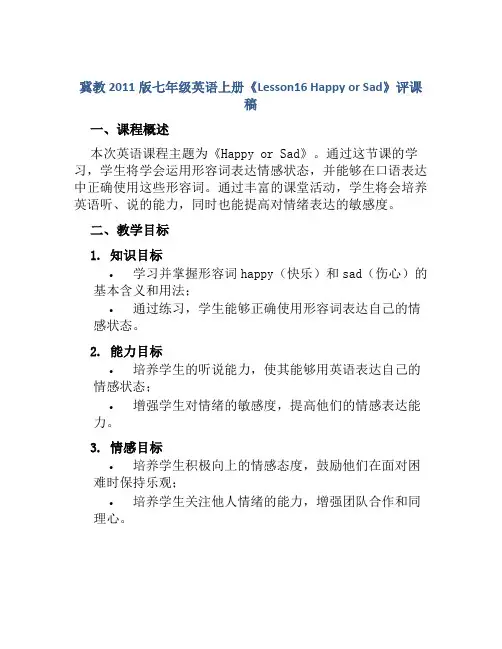
冀教2011版七年级英语上册《Lesson16 Happy or Sad》评课稿一、课程概述本次英语课程主题为《Happy or Sad》。
通过这节课的学习,学生将学会运用形容词表达情感状态,并能够在口语表达中正确使用这些形容词。
通过丰富的课堂活动,学生将会培养英语听、说的能力,同时也能提高对情绪表达的敏感度。
二、教学目标1. 知识目标•学习并掌握形容词happy(快乐)和sad(伤心)的基本含义和用法;•通过练习,学生能够正确使用形容词表达自己的情感状态。
2. 能力目标•培养学生的听说能力,使其能够用英语表达自己的情感状态;•增强学生对情绪的敏感度,提高他们的情感表达能力。
3. 情感目标•培养学生积极向上的情感态度,鼓励他们在面对困难时保持乐观;•培养学生关注他人情绪的能力,增强团队合作和同理心。
三、教学重点1. 掌握形容词happy和sad的用法;2. 学会运用形容词来表达自己的情感状态。
四、教学准备1. 教具准备•PPT课件;•录音机。
2. 物资准备•学生课本《Lesson 16 Happy or Sad》;•黑板、白板和相应的书写工具。
五、教学过程1. 导入(5分钟)教师以简单的问候开始课程,引发学生对情感的思考。
并通过几个简短的问题开展小组讨论,例如:“你们今天心情如何?为什么?” “你们最喜欢的快乐的事情是什么?”等等。
2. 新知呈现(10分钟)通过PPT呈现happy和sad两个单词的图片,并播放对应的发音,帮助学生理解这些单词的意思与读音。
3. 听力训练(15分钟)全班学生听录音,跟读并模仿录音中的语调和语音节奏。
通过听力训练,学生能够更好地掌握课文中形容词happy和sad的用法。
4. 团体讨论(15分钟)将学生分成小组,让他们在小组内分享和讨论自己的快乐或伤心的事情,并用英语表达出来。
鼓励每个学生都参与进来,并尝试用上本节课中所学的形容词。
5. 练习与巩固(15分钟)教师提供一系列与快乐和伤心相关的图片,并让学生通过观察图片,用英语表达出相应的情感状态。
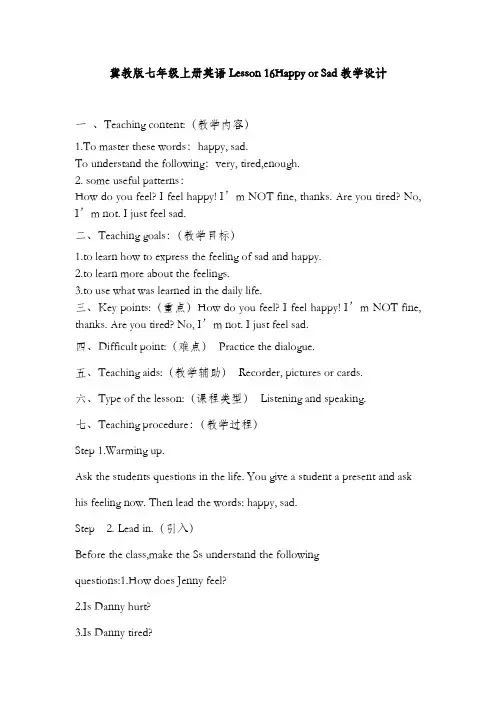
冀教版七年级上册英语Lesson 16Happy or Sad教学设计一、Teaching content:(教学内容)1.To master these words:happy, sad.To understand the following:very, tired,enough.2. some useful patterns:How do you feel? I feel happy! I’m NOT fine, thanks. Are you tired? No, I’m not. I just feel sad.二、Teaching goals:(教学目标)1.to learn how to express the feeling of sad and happy.2.to learn more about the feelings.3.to use what was learned in the daily life.三、Key points:(重点)How do you feel? I feel happy! I’m NOT fine, thanks. Are you tired? No, I’m not. I just feel sad.四、Difficult point:(难点)Practice the dialogue.五、Teaching aids:(教学辅助)Recorder, pictures or cards.六、Type of the lesson:(课程类型)Listening and speaking.七、Teaching procedure:(教学过程)Step 1.Warming up.Ask the students questions in the life. You give a student a present and ask his feeling now. Then lead the words: happy, sad.Step 2. Lead in.(引入)Before the class,make the Ss understand the followingquestions:1.How does Jenny feel?2.Is Danny hurt?3.Is Danny tired?Step 3. New lesson.(新课)No. 1 Give the presents that you prepared to the students that do well. Then ask “How do you feel?”Explain it in Chinese when it is necessary. Help them answer “I’m happy.”Then take their presents away and ask “How do you feel now?”Help them answer “I’m sad”No. 2Begin “happy, sad”game in pairs, using the presents that we prepared before the class. The best one will get a present.Let’s sing a song together. Listen to the tape and sing happily after it. Encourage students to sing loudly because what we need is a happy feeling. The students can stand up and do according to the text.Step 4. Play the tape for the Ss to follow.Step 5.Summary. (小结)Sum up sentences:How do you feel?Step 6. Homework.(作业)Finish the activity book.Step 7.Blackboard-writing:(板书)八.Teaching reflection:(教后反思)。
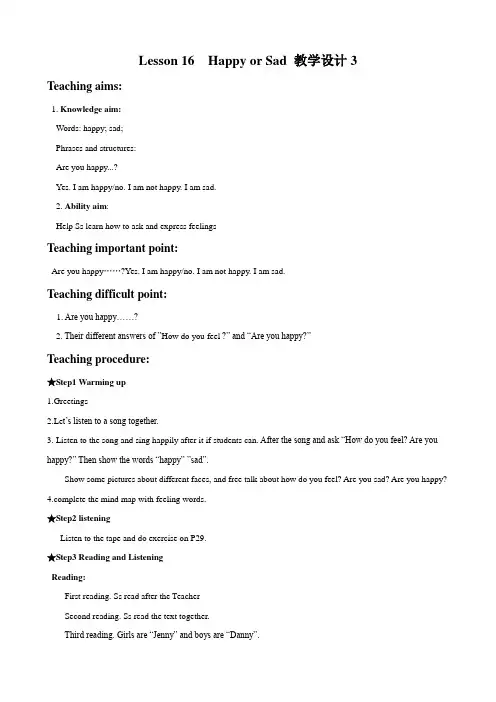
Lesson 16 Happy or Sad 教学设计3Teaching aims:1. Knowledge aim:Words: happy; sad;Phrases and structures:Are you happy...?Yes. I am happy/no. I am not happy. I am sad.2. Ability aim:Help Ss learn how to ask and express feelingsTeaching important point:Are you happy……?Yes. I am happy/no. I am not happy. I am sad.Teaching difficult point:1. Are you happy……?2. Their different answers of ”How do you feel ?” and “Are you happy?”Teaching procedure:★Step1 Warming up1.Greetings2.Le t’s listen to a song together.3. Listen to the song and sing happily after it if students can. After the song and ask “How do you feel? Are you happy?”Then show the words “happy””sad”.Show some pictures about different faces, and free talk about how do you feel? Are you sad? Are you happy?plete the mind map with feeling words.★Step2 listeningListen to the tape and do exercise on P29.★Step3 Reading and ListeningReading:First reading. Ss read after the TeacherSecond reading. Ss read the text together.Third reading. Girls are “Jenny” and boys are “Danny”.Listening:listen to the tape carefully.★Step4 Explanation the textAre you happy……?★Step5 Speaking(dialogue time)Work with your partner and make a new conversation.★Step6 Summarynguage point.Are you happy……?I feel/am happy/sad2.Let’s chant!★Step8 Homework:Work in pairs. Are you happy……?Make up a dialogue.(编对话) Blackboard designingLesson 16 Happy or SadAre you happy...?Yes. I am happy/no. I am not happy. I am sad.。
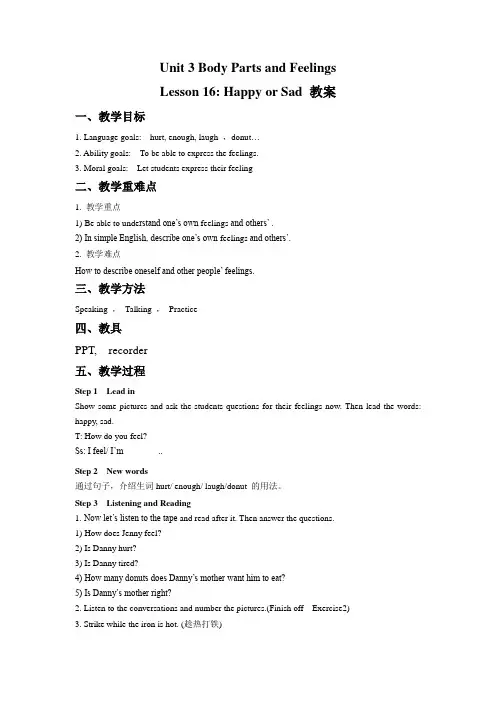
Unit 3 Body Parts and FeelingsLesson 16: Happy or Sad 教案一、教学目标1. Language goals: hurt, enough, laugh ,donut…2. Ability goals: To be able to express the feelings.3. Moral goals: Let students express their feeling二、教学重难点1. 教学重点1) Be able to unde rstand one’s own feelings and others’ .2) In simple English, describe one’s own feelings and others’.2. 教学难点How to describe oneself and other people’ feelings.三、教学方法Speaking ,Talking ,Practice四、教具PPT, recorder五、教学过程Step 1 Lead inShow some pictures and ask the students questions for their feelings now. Then lead the words: happy, sad.T: How do you feel?Ss: I feel/ I’m________..Step 2 New words通过句子,介绍生词hurt/ enough/ laugh/donut 的用法。
Step 3 Listening and Reading1.Now let’s listen to the tape and read after it. Then answer the questions.1) How does Jenny feel?2) Is Danny hurt?3) Is Danny tired?4) How many donuts does Danny’s mother want him to eat?5) Is Danny’s mother right?2. Listen to the conversations and number the pictures.(Finish off Exercise2)3. Strike while the iron is hot. (趁热打铁)Finish off Exercise4Step4 Teach the main language points1. How do you feel? 主要用来询问对方的感觉如何。
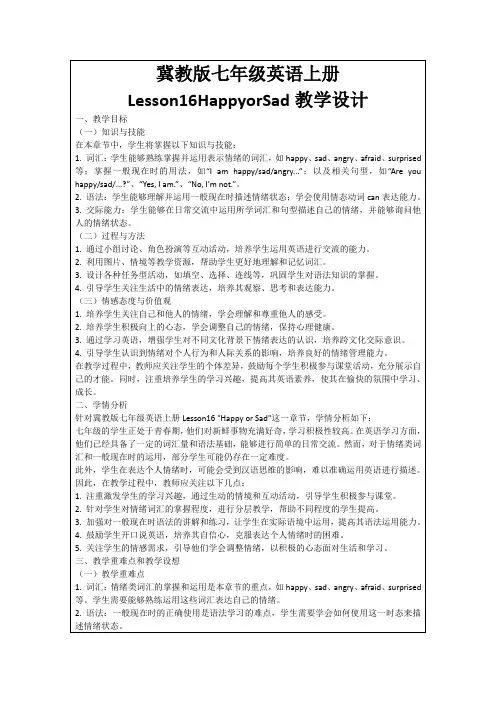
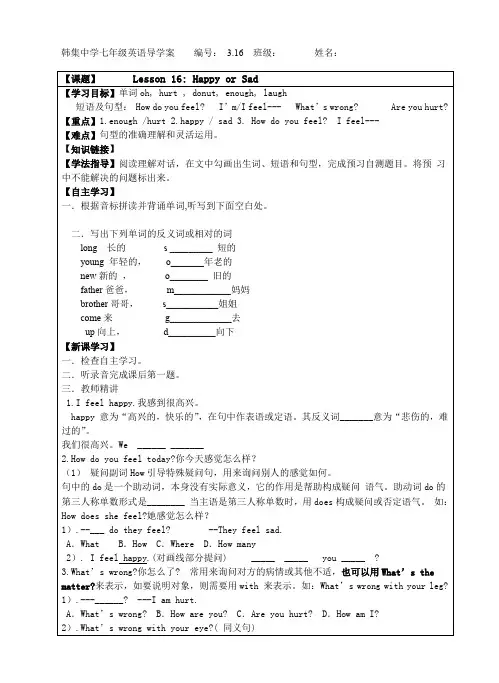
韩集中学七年级英语导学案编号:3.16 班级:姓名:【课题】Lesson 16: Happy or Sad【学习目标】单词oh, hurt , donut, enough, laugh短语及句型: How do you feel? I’m/I feel--- What’s wrong? Are you hurt? 【重点】1.enough /hurt 2.happy / sad 3. How do you feel? I feel---【难点】句型的准确理解和灵活运用。
【知识链接】【学法指导】阅读理解对话,在文中勾画出生词、短语和句型,完成预习自测题目。
将预习中不能解决的问题标出来。
【自主学习】一.根据音标拼读并背诵单词,听写到下面空白处。
二.写出下列单词的反义词或相对的词long 长的s _________ 短的young 年轻的,o_______年老的new新的,o________ 旧的father爸爸,m____________妈妈brother哥哥,s___________姐姐come来g_____________去up向上,d__________向下【新课学习】一.检查自主学习。
二.听录音完成课后第一题。
三.教师精讲1.I feel happy.我感到很高兴。
happy 意为“高兴的,快乐的”,在句中作表语或定语。
其反义词_______意为“悲伤的,难过的”。
我们很高兴。
We ______ _______2.How do you feel today?你今天感觉怎么样?(1)疑问副词How引导特殊疑问句,用来询问别人的感觉如何。
句中的do是一个助动词,本身没有实际意义,它的作用是帮助构成疑问语气。
助动词do的第三人称单数形式是________ 当主语是第三人称单数时,用does构成疑问或否定语气。
如:How does she feel?她感觉怎么样?1).--___ do they feel? --They feel sad.A.What B.How C.Where D.How many2). I feel happy.(对画线部分提问) _____ _____ you _____ ?3.What’s wrong?你怎么了? 常用来询问对方的病情或其他不适,也可以用What’s the matter?来表示,如要说明对象,则需要用with 来表示。
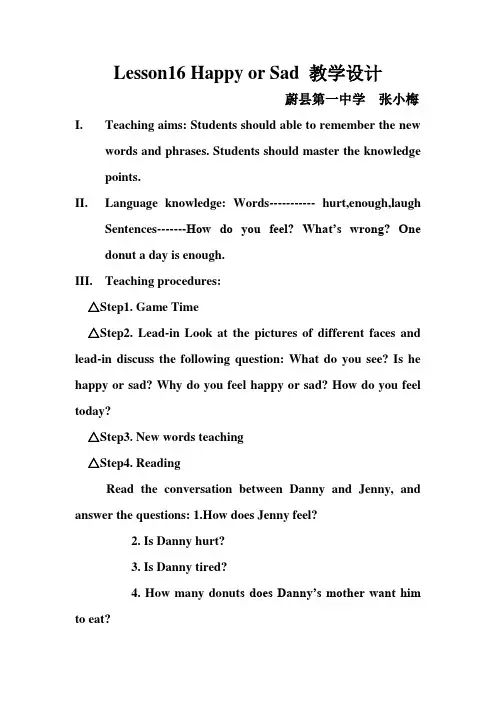
Lesson16 Happy or Sad 教学设计蔚县第一中学张小梅I.Teaching aims: Students should able to remember the newwords and phrases. Students should master the knowledge points.nguage knowledge: Words----------- hurt,enough,laugh Sentences-------How do you feel? What’s wrong? One donut a day is enough.III.Teaching procedures:△Step1. Game Time△Step2. Lead-in Look at the pictures of different faces and lead-in discuss the following question: What do you see? Is he happy or sad? Why do you feel happy or sad? How do you feel today?△Step3. New words teaching△Step4. ReadingRead the conversation between Danny and Jenny, and answer the questions: 1.How does Jenny feel?2. Is Danny hurt?3. Is Danny tired?4. How many donut s does Danny’s mother want him to eat?5. Is Danny’s mother right?△Step5. PairworkTalk about feelings,using “How do you feel today?”△Step6. Listening PartIn this part you’ll listen to four conversations, master the main points, then number the pictures.△Step7. GroupworkHere are four groups of exercises, choose one of them, do the exercises and have a competition.△Step8. If you are happyEnjoy a song “If you are happy? to fi nish the class.。
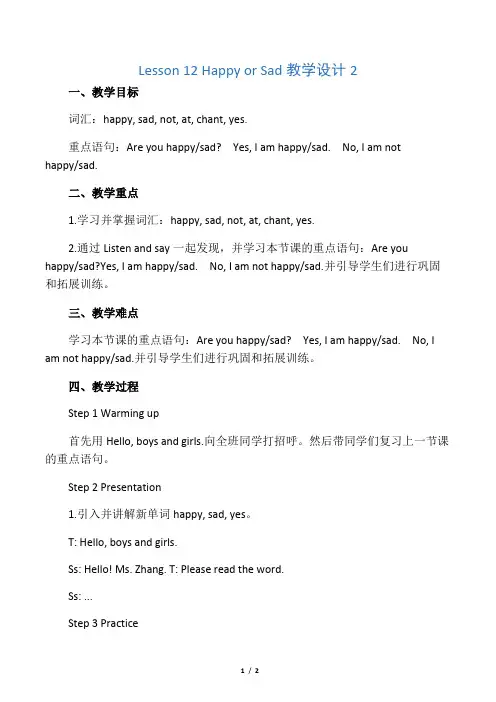
Lesson 12 Happy or Sad教学设计2一、教学目标词汇:happy, sad, not, at, chant, yes.重点语句:Are you happy/sad? Yes, I am happy/sad. No, I am nothappy/sad.二、教学重点1.学习并掌握词汇:happy, sad, not, at, chant, yes.2.通过Listen and say一起发现,并学习本节课的重点语句:Are you happy/sad?Yes, I am happy/sad. No, I am not happy/sad.并引导学生们进行巩固和拓展训练。
三、教学难点学习本节课的重点语句:Are you happy/sad? Yes, I am happy/sad. No, I am not happy/sad.并引导学生们进行巩固和拓展训练。
四、教学过程Step 1 Warming up首先用Hello, boys and girls.向全班同学打招呼。
然后带同学们复习上一节课的重点语句。
Step 2 Presentation1.引入并讲解新单词happy, sad, yes。
T: Hello, boys and girls.Ss: Hello! Ms. Zhang. T: Please read the word.Ss: ...Step 3 Practice让同学们运用句子:Are you happy/sad? Yes, I am happy/sad. No, I am not happy/sad.Ss1::Are you happy?Ss2: Yes, I am happy.Ss3:Are you happy?五、课后作业背诵并默写新学的单词;背诵文中的对话,利用课余时间与同学利用所学的句子进行交流。
六、板书设计Lesson 16 Happy or sadhappy, sad, not, at, chant, yes.Are you happy/sad? Yes, I am happy/sad. No, I am not happy/sad.。
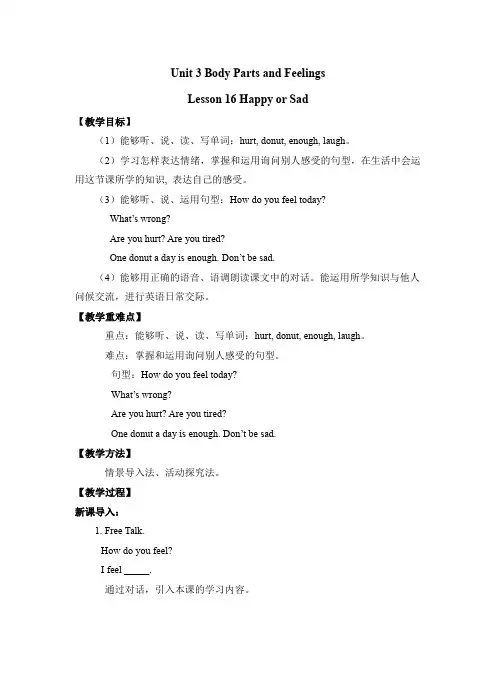
Unit 3 Body Parts and FeelingsLesson 16 Happy or Sad【教学目标】(1)能够听、说、读、写单词:hurt, donut, enough, laugh。
(2)学习怎样表达情绪,掌握和运用询问别人感受的句型,在生活中会运用这节课所学的知识, 表达自己的感受。
(3)能够听、说、运用句型:How do you feel today?What’s wrong?Are you hurt? Are you tired?One donut a day is enough. Don’t be sad.(4)能够用正确的语音、语调朗读课文中的对话。
能运用所学知识与他人问候交流,进行英语日常交际。
【教学重难点】重点:能够听、说、读、写单词:hurt, donut, enough, laugh。
难点:掌握和运用询问别人感受的句型。
句型:How do you feel today?What’s wrong?Are you hurt? Are you tired?One donut a day is enough. Don’t be sad.【教学方法】情景导入法、活动探究法。
【教学过程】新课导入:1. Free Talk.How do you feel?I feel _____.通过对话,引入本课的学习内容。
2. Let’s sing the song! 歌曲引入本课学习内容。
新课讲授:Step 1 New words and expression.(1) hurt [hɜːt](v. 伤害、疼痛adj. 受伤的、痛的)He hurts his foot.His foot is hurt.(2) enough adj. & adv. 足够的(地)He has enough money to buy a car.他有足够的钱买一辆汽车。
(3) donut n. 面包圈This shop sells different kinds of donuts.(4) laugh v. 笑You should laugh every day.每天都要笑。
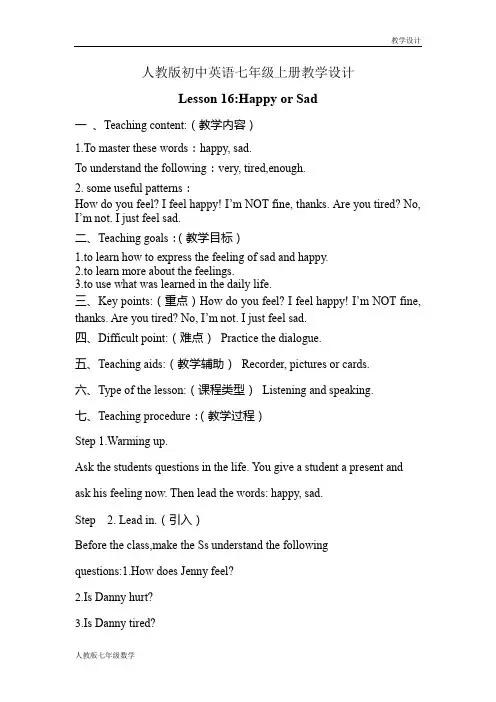
人教版初中英语七年级上册教学设计Lesson 16:Happy or Sad一、Teaching content:(教学内容)1.To master these words:happy, sad.To understand the following:very, tired,enough.2. some useful patterns:How do you feel? I feel happy! I’m NOT fine, thanks. Are you tired? No, I’m not. I just feel sad.二、Teaching goals:(教学目标)1.to learn how to express the feeling of sad and happy.2.to learn more about the feelings.3.to use what was learned in the daily life.三、Key points:(重点)How do you feel? I feel happy! I’m NOT fine, thanks. Are you tired? No, I’m not. I just feel sad.四、Difficult point:(难点)Practice the dialogue.五、Teaching aids:(教学辅助)Recorder, pictures or cards.六、Type of the lesson:(课程类型)Listening and speaking.七、Teaching procedure:(教学过程)Step 1.Warming up.Ask the students questions in the life. You give a student a present and ask his feeling now. Then lead the words: happy, sad.Step 2. Lead in.(引入)Before the class,make the Ss understand the followingquestions:1.How does Jenny feel?2.Is Danny hurt?3.Is Danny tired?Step 3. New lesson.(新课)No. 1 Give the presents that you prepared to the students that do well. Then ask “How do you feel?” Explain it in Chinese when it is necessary. Help them answer “I’m happy.” Then take their presents away and ask “How do you feel now?” Help them answer “I’m sad”No. 2Begin “happy, sad” game in pairs, using the presents that we prepared before the class. The best one will get a present.Let’s sing a song together. Listen to the tape and sing happily after it. Encourage students to sing loudly because what we need is a happy feeling. The students can stand up and do according to the text.Step 4. Play the tape for the Ss to follow.Step 5.Summary. (小结)Sum up sentences:How do you feel?Step 6. Homework.(作业)Finish the activity book.Step 7.Blackboard-writing:(板书)。
2)Is Danny tired?3)How many donuts does Danny’s mother want him to eat?4)Is Danny’s mother right?Step4 Teach the main language points1.How do you feel today?常见答语:—I feel ..../I’m ....— I don’t feel ..../I’m not ....—How does he/she feel?—He/She feels ....2.One donut a day is enough.enough 作a dj.,意为“足够的:充足的”,放在 n. 的前面或 be 动词的后面.eg: enough rain [enough+n.]One donut a day is enough.[be 动词+enough] 作adv. 只能放在 adj.或 adv.的后面eg: The girl is old enough to go to school.The girl walks fast enough to go to school.Step 5 ActivityWork in pairs. How do you feel today? Make up a dialogue. Step6SummaryKey words: hurt, enough, laugh, donut Keypoints: 1.How do you feel?I feel happy/sad/tired2.What's wrong?Step7 PracticeDo some exercises Step8Homework1.Read the dialogue in different roles with your partner.2.After getting home,ask your parents’ feelings.板书设计Lesson 16: Happy or Sad 一.New wordshurt, enough, laugh ,donut 二.The main language points1.用来询问对方的感觉如何的句型。
happyorsad教案幼儿园教案标题:《快乐还是悲伤?》幼儿园教案教学目标:1. 帮助幼儿认识快乐和悲伤这两种情绪,并能区分它们的表现和原因。
2. 培养幼儿正确表达和处理自己的情绪,增强情绪管理能力。
3. 通过游戏和互动活动,促进幼儿的社交能力和合作精神。
教学内容:1. 情绪认知:a. 快乐的表现:笑脸、欢笑、跳跃等。
b. 悲伤的表现:哭泣、低头、不愿交流等。
c. 快乐和悲伤的原因:玩具被抢走、朋友离开等。
2. 情绪表达:a. 通过绘画、手工制作等方式,让幼儿表达自己的快乐和悲伤。
b. 通过角色扮演,让幼儿模拟不同情绪的表达方式。
3. 情绪管理:a. 引导幼儿探讨快乐和悲伤对身心的影响,并讨论积极应对的方式。
b. 教授幼儿简单的放松和情绪调节方法,如深呼吸、亲近大自然等。
4. 合作与分享:a. 组织幼儿进行小组游戏,鼓励互相合作和分享快乐。
b. 引导幼儿关注他人的情绪,学会安慰和帮助他人。
教学步骤:1. 导入活动:a. 唱一首快乐的歌曲,让幼儿跟着节奏舞动。
b. 展示一张笑脸和一张哭脸的图片,询问幼儿这两种表情代表什么情绪。
2. 情绪认知:a. 通过图片和实物等展示不同情绪的表现方式,引导幼儿讨论和描述。
b. 用简单的语言解释快乐和悲伤的原因,让幼儿理解情绪产生的背景。
3. 情绪表达:a. 给幼儿提供纸、颜料、画笔等材料,让他们用绘画表达自己的快乐和悲伤。
b. 安排角色扮演活动,让幼儿模拟不同情绪的表达方式,例如快乐时跳舞、悲伤时低头哭泣等。
4. 情绪管理:a. 引导幼儿讨论快乐和悲伤对身心的影响,并鼓励他们分享自己的感受。
b. 教授幼儿简单的放松和情绪调节方法,如深呼吸、亲近大自然等。
5. 合作与分享:a. 组织幼儿进行小组游戏,如传球游戏,鼓励他们互相合作和分享快乐。
b. 引导幼儿关注他人的情绪,通过角色扮演等方式学会安慰和帮助他人。
6. 总结活动:a. 回顾今天的学习内容,让幼儿总结快乐和悲伤的表现和原因。
Happy or SadUnit 7 Sports and Good Health Lesson 41 Were People Healthy Then Teaching goals 教学目标1. Target language 目标语言a. 掌握词汇及短语spend, naturalgo fishing/hunting, First Nations, at that time, make a fire, a long time ago. hunt forb. 句型1) Grandpa, did people go fishing a long time ago2) They spent a lot of time outdoors.2. Ability goals 能力目标Enable students to know the differences between now and then.3. Learning ability goals 学能目标Help students know some cultures.Teaching important and difficult points 教学重难点To grasp the use of some words.Teaching methods教学方法Listening and speaking.Teaching aids 教具准备Audiotape.Teaching procedures & ways 教学步骤与方式Step I Greeting and lead-inReview lesson 40 and lead in new lesson.T: Do you know the life a long time agoS:….T: What do they often do a long time agoGet students to talk about the differences between life then and life now.Step II Learn the textListen to the tape and finish exercise 1from“Let’s Do It〞Read the lesson and finish exercise 2 from “Let’s Do It〞Step II Grasp some important phrases and sentences of the text.Phrasesgo fishing/hunting 去钓鱼/打猎at that time 在那个时候make a fire 生火a long time ago 很久以前hunt for 寻找Sentences1〕Grandpa, did people go fishing a long time ago 爷爷,在很久以前人们钓鱼吗?go fishing 意为“去钓鱼〞,其构成形式为 go+doing常见的词组还有:go swimming 去游泳; go skiing 去滑雪;go skating 去滑冰;go climbing mountain 去爬山2〕At that time, there were no supermarkets. 那时候还没有超市。
《Happy or Sad 》说课稿尊敬的各位评委、老师们:大家好!今天我说课的题目是《Happy or Sad 》。
下面我将从教材分析、学情分析、教学目标、教学重难点、教学方法、教学过程以及教学反思这几个方面来展开我的说课。
一、教材分析《Happy or Sad 》是教材版本教材中具体单元的内容。
本单元围绕“情绪”这一主题展开,通过生动的图片、有趣的对话和丰富的练习,帮助学生学习和掌握表达快乐和悲伤等情绪的词汇和句型。
教材中的内容贴近学生的生活实际,能够引起学生的共鸣,激发他们的学习兴趣。
同时,教材的编排注重语言的实用性和交际性,为学生提供了大量的语言实践机会,有助于培养学生的语言运用能力。
二、学情分析我所教授的学生是具体年级的学生,他们经过了一定时间的英语学习,已经具备了一定的英语基础知识和语言技能。
这个年龄段的学生活泼好动,好奇心强,喜欢参与各种活动。
但是,他们的注意力集中时间较短,需要通过多样化的教学方法和活动来吸引他们的注意力,提高他们的学习积极性。
在语言方面,学生已经掌握了一些常见的形容词和简单的句子结构,但对于情绪类词汇的准确表达和运用还不够熟练,需要进一步的学习和巩固。
三、教学目标基于对教材和学情的分析,我制定了以下教学目标:1、知识目标(1)学生能够准确认读和理解单词:happy, sad, angry, tired 等。
(2)学生能够熟练运用句型:I'm happy / He's sad 等来表达自己和他人的情绪。
2、技能目标(1)学生能够听懂关于情绪的简单对话,并能做出正确的回应。
(2)学生能够用英语简单地描述自己和他人的情绪状态。
3、情感目标(1)培养学生关注自己和他人情绪的意识,学会理解和关心他人。
(2)让学生在学习中体验到快乐,增强学习英语的自信心和兴趣。
四、教学重难点1、教学重点(1)掌握表示情绪的单词:happy, sad, angry, tired 等。
Lesson 16 Happy or Sad 教学设计3Teaching aims:1. Knowledge aim:Words: happy; sad;Phrases and structures:Are you happy...?Yes. I am happy/no. I am not happy. I am sad.2. Ability aim:Help Ss learn how to ask and express feelingsTeaching important point:Are you happy……?Yes. I am happy/no. I am not happy. I am sad.Teaching difficult point:1. Are you happy……?2. Their different answers of ”How do you feel ?” and “Are you happy?”Teaching procedure:★Step1 Warming up1.Greetings2.Le t’s listen to a song together.3. Listen to the song and sing happily after it if students can. After the song and ask “How do you feel? Are you happy?”Then show the words “happy””sad”.Show some pictures about different faces, and free talk about how do you feel? Are you sad? Are you happy?plete the mind map with feeling words.★Step2 listeningListen to the tape and do exercise on P29.★Step3 Reading and ListeningReading:First reading. Ss read after the TeacherSecond reading. Ss read the text together.Third reading. Girls are “Jenny” and boys are “Danny”.Listening:listen to the tape carefully.★Step4 Explanation the textAre you happy……?★Step5 Speaking(dialogue time)Work with your partner and make a new conversation.★Step6 Summarynguage point.Are you happy……?I feel/am happy/sad2.Let’s chant!★Step8 Homework:Work in pairs. Are you happy……?Make up a dialogue.(编对话) Blackboard designingLesson 16 Happy or SadAre you happy...?Yes. I am happy/no. I am not happy. I am sad.。